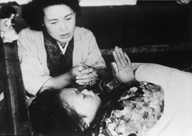Still It’s Good to Live
(“Ikite ite yokatta”) 1956 / B&W / 35mm / 49 min
1956 / B&W / 35mm / 49 min
Directors: Kamei Fumio / Teshigahara Hiroshi, Yamazaki Seikyo
Photography: Kuroda Kiyomi, Segawa Hiroshi
Editing: Jinbo Haruo, Shuzui Fusako
Sound: Okuyama Junosuke, Ohashi Tetsuya
Music: Nagasawa Katsutoshi
Line Producer: Saito Shigeo
Narrator: Yamada Mitsuko
Producer: Ono Tadashi
Production Companies: Japan Council against A & H Bombs, Japan Document Film
Source: Japan Document Film
This film was planned as part of the movement to aid atomic bomb victims at the First World Conference against A & H Bombs held on August 6 and 9, 1955. The film first “quotes” from The Effects of the Atomic Bomb on Hiroshima and Nagasaki (“Genshi bakudan no koka—Hiroshima-Nagasaki,” 1946) shot by Miki Shigeru and others—a film which managed to evade confiscation—to show the horrible situation of people immediately after the atomic bomb blasts. It then introduces us to the painful existence of bomb survivors who continue to endure leukemia, keloids, and other ailments. As a result of America’s experimental detonation of a hydrogen bomb at Bikini Atoll in 1954, fishermen aboard the Daigo Fukuryu Maru were exposed to radiation. As the threat of a third world war loomed large during the Cold War and public opposition to nuclear arms increased, this film was shown in Ginza’s Namiki-za and other commercial cinemas around Japan. Funding for the film came from radiation survivors’ relief fund money sent in from around the world, and it was produced by the Japan Council against A & H Bombs, a national umbrella organization of anti-nuclear groups. The Council against A & H Bombs in Hiroshima and Nagasaki helped out greatly with local filming.
